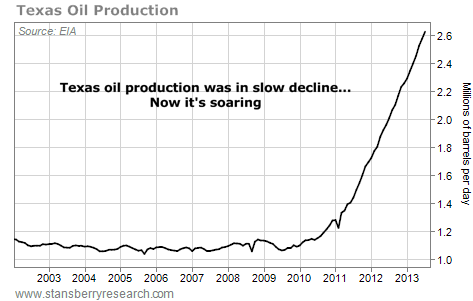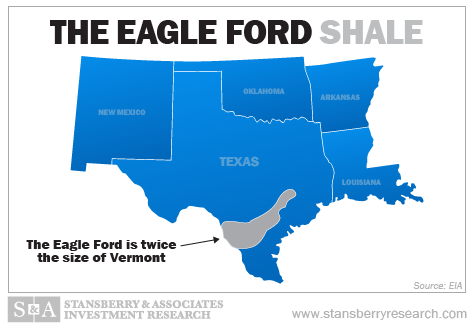| Home | About Us | Resources | Archive | Free Reports | Market Window |
A "Boots on the Ground" Look at the Century's Biggest Resource StoryBy
Wednesday, October 9, 2013
"I'm sorry, Mr. Badiali. I can only confirm your room for two nights."
The hotel was on a back road in southeast Texas. The parking lot looked like a truck dealership. New pickup trucks filled nearly every spot.
Like every other hotel in the area, you couldn't book a hotel for three nights. I wanted to book at least three nights... but so did thousands of oil workers.
Last month, I traveled to the heart of Texas oil country... the Eagle Ford Shale. I found all the signs of a huge resource boom.
You might have heard of the Eagle Ford already. But you probably don't know the full picture. Here's the latest…
Texas oil production is an anomaly.
Oil production in places like Saudi Arabia, Nigeria, Mexico, Qatar... practically everywhere else... is in slow decline. Giant conventional oilfields found in the 1950s and 1960s are winding down.
And until recently, Texas was following the same trend... From 2004 to 2009, Texas oil production flattened out at around 1.1 million barrels per day.
But today, Texas oil production is soaring.
From 2009 to 2012, daily oil production rose 140%. By June 2013, Texas' daily oil production hit 2.6 million barrels.
 In 2009, Texas oil production made up just 19% of the total U.S. oil production. It now makes up 36% of the total U.S. daily oil production.
To put all this into a global context, Texas produces more oil today than Nigeria, a major international oil producer. It's only 200,000 barrels per day less than Venezuela, another major oil producer.
In other words, if Texas were a country, it would be the world's 12th-largest producer.
A big part of Texas oil production – about 31% – comes from the Eagle Ford.
The Eagle Ford is the name of the rocks that filled a deep-water canyon that existed over 100 million years ago in southeast Texas. The trough trapped a thick, continuous layer of organic-rich sediments. Over time, heat and pressure converted the organics into oil and gas.
Some of the oil and gas leaked into surrounding rocks, creating some of the legendary Texas oilfields. But today, the "source" rocks are the target.
Just five years ago, geologists thought these source rocks were limited to just four key counties in southeast Texas. Today, we know the Eagle Ford runs for 20,000 square miles under a swath of Texas. It stretches from southeast of San Antonio down into Mexico. It's twice the size of Vermont.
 According to the Railroad Commission of Texas (which regulates the state's oil and gas production), the Eagle Ford generated 38,000 full-time jobs in 2011. The average oil-industry job paid $117,000 per year. In all, the Eagle Ford provided $25 billion in economic benefit to Texas… That was larger than the economy of the state of Vermont that year.
And according to the same folks, the state will receive over $62 billion in economic benefit from developing the Eagle Ford shale by 2021. That's larger than the economies of 13 states this year.
Think about that... the economic benefit from a single new shale discovery will generate more money for Texas than 13 states generated with their entire economies.
Already, oil production from the Eagle Ford is around 800,000 barrels per day. According to investment bank Jefferies & Co., oil production in the Eagle Ford will grow to over 1 million barrels per day by next summer.
Another estimate, from industry research broker ITG Inc., puts the Eagle Ford's production at 3 million barrels per day in 2019.
This shale is huge and growing fast. If you're looking for great investment opportunities in the energy space, you should start right here.
Tomorrow, I'll show you what makes the Eagle Ford such a great target… and a few of the top names working in the area.
Good investing,
Matt Badiali
Further Reading:
"According to the U.S. Energy Information Administration, domestic crude oil production will hit 7.8 million barrels per day by 2014," Matt writes. "It represents an astonishing 56% increase from the recent low of 5 million barrels per day in 2008." Get all the details on America's huge increase in oil production – and the chart energy investors have to see – right here.
DailyWealth Classic: Porter Stansberry introduced readers to the Eagle Ford in 2010, when daily oil production was less than a tenth of what it is today. Find his two-part series here:
The Most Important U.S. Oil Discovery in 40 Years
"I expect Eagle Ford to yield more than $2 billion in oil and gas by 2013 and to increase steadily for at least 20 years." How to Buy the Biggest Oilfield Left in Texas
"How did a giant oilfield suddenly appear in Texas – an area that's been thoroughly studied and drilled since the 1930s?" Market NotesTHE CHEAPEST STOCKS IN THE WORLD Today's chart displays a stock rally happening in a place you'd never expect. It shows the rally in Greece.
Most folks know the current "Greece story." It's an economic basket case. It has spent and borrowed its way into a depression. Unemployment is over 20%. Things seem hopeless to lots of people there.
The rough times took their toll on the Greek stock market. From its October 2007 peak to the June 2012 lows, the Athens Stock Exchange fell 91%. But today's chart shows how stock markets can stage huge rallies when things are bleak...
Since bottoming in 2012, the Greek stock market has rallied more than 100%. And while the U.S. stock market has been flat since early July, Greek stocks are up 36%. Even after the rally, Greek stocks are among the cheapest in the world. This move higher still has plenty of room to run.
 |
In The Daily Crux
Recent Articles
|


